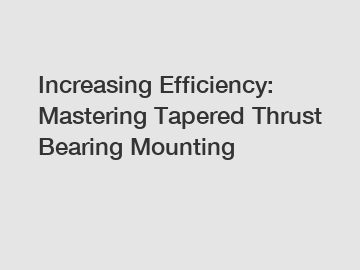Increasing Efficiency: Mastering Tapered Thrust Bearing Mounting
Increasing Efficiency: Mastering Tapered Thrust Bearing Mounting.
Tapered thrust bearings play a crucial role in various applications such as automotive, aerospace, and industrial machinery. These bearings are designed to handle both radial and axial loads, making them essential for supporting heavy loads and facilitating smooth rotary motion. However, to fully harness the benefits of tapered thrust bearings, it is vital to master their proper mounting techniques. In this article, we will explore the importance of mastering tapered thrust bearing mounting, delve into the process of achieving optimal mounting, and discuss the profound impact it can have on efficiency and performance.
The significance of mastering tapered thrust bearing mounting lies in the fact that improper installation can lead to premature wear, increased friction, and reduced overall performance. These consequences can result in costly repairs, excessive downtime, and decreased equipment lifespan. Therefore, understanding and implementing the correct mounting procedures is pivotal in maximizing the efficiency and longevity of tapered thrust bearings.

Achieving optimal mounting begins with thorough preparation. Prior to installation, it is imperative to inspect the bearing for any signs of damage, ensure cleanliness, and verify proper lubrication. Any defects or contaminants can significantly affect the bearing's performance and compromise its ability to handle loads effectively. Additionally, it is crucial to select the appropriate mounting method based on the specific application requirements and bearing characteristics. Some common mounting methods include the shaft fitting or withdrawal sleeve method, hydraulic mounting, and induction heating.
Once the proper mounting method is determined, the next step is to carefully align the bearing components. Misalignment can lead to uneven distribution of loads, increased friction, and premature failure. Proper alignment not only ensures optimal load distribution but also minimizes the risk of damage to surrounding components. Precision alignment can be achieved through techniques such as the use of alignment shims, laser aligning systems, or even the skills of expert technicians.
Furthermore, ensuring the correct axial preload is critical for achieving optimal performance. Axial preload refers to the intentional application of a specific load in the axial direction to eliminate internal clearance within the bearing. This preload helps to reduce vibration, increase stiffness, and enhance overall bearing performance. Achieving the proper axial preload requires carefully controlled force application and the use of specialized tools or measurement devices.
The mastery of tapered thrust bearing mounting techniques can have a profound impact on efficiency and performance. Properly mounted bearings offer reduced friction, improved load distribution, enhanced stiffness, and increased service life. These benefits translate into higher equipment efficiency, reduced energy consumption, and greater productivity. Additionally, accurate bearing mounting ensures a safer working environment by minimizing the risk of sudden failures or breakdowns.
In conclusion, mastering tapered thrust bearing mounting is essential for maximizing efficiency, reducing operational costs, and enhancing overall performance. Through proper preparation, alignment, and axial preload, the full potential of these bearings can be realized. By investing time and effort into mastering these techniques, engineers and technicians can contribute to the advancement and success of various industries, where tapered thrust bearings are employed.
If you want to learn more, please visit our website automotive bearing supplier, Overhead Conveyor Guide Wheel wholesale, motor bearing wholesale.

Comments
0